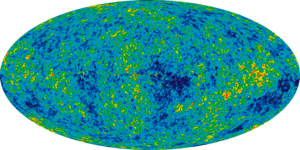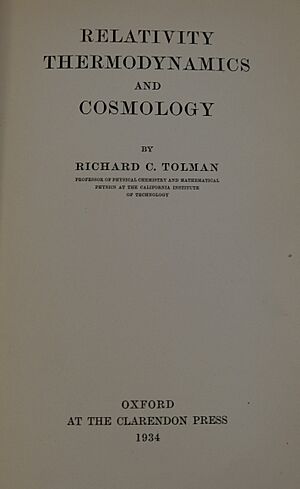Richard C. Tolman facts for kids
Quick facts for kids
Richard C. Tolman
|
|
|---|---|

Richard C. Tolman in 1945
|
|
| Born | March 4, 1881 West Newton, Massachusetts, U.S.
|
| Died | September 5, 1948 (aged 67) Pasadena, California, U.S.
|
| Alma mater | Massachusetts Institute of Technology |
| Scientific career | |
| Fields | Physical chemistry Statistical Mechanics Cosmology |
| Institutions | California Institute of Technology |
| Thesis | The Electromotive Force Produced in Solutions by Centrifugal Action (1910) |
| Doctoral advisor | Arthur Amos Noyes |
| Doctoral students | Allan C. G. Mitchell Linus Pauling |
Richard Chace Tolman (born March 4, 1881 – died September 5, 1948) was an American scientist. He was a mathematical physicist and physical chemist. He made many important discoveries in statistical mechanics, which studies how large groups of tiny particles behave.
Tolman also helped develop theoretical cosmology. This field looks at the universe's origin, structure, and future. He did this soon after Albert Einstein shared his ideas about general relativity. Tolman taught physical chemistry and mathematical physics at the California Institute of Technology (Caltech).
Contents
A Scientist's Journey
| Physical cosmology | ||||||||||||||
 |
||||||||||||||
| Universe · Big Bang Age of the universe Timeline of the Big Bang Ultimate fate of the universe
|
||||||||||||||
Richard Tolman was born in West Newton, Massachusetts. He studied chemical engineering at the Massachusetts Institute of Technology (MIT). He earned his first degree in 1903 and his PhD in 1910. His main teacher was Arthur Amos Noyes.
In 1924, he married Ruth Sherman Tolman.
Early Discoveries
In 1912, Tolman came up with the idea of relativistic mass. This concept explains how the mass of an object changes when it moves very fast. He wrote that a moving object's mass is best described by a special formula.
In 1916, Tolman worked with Thomas Dale Stewart on an experiment. They showed that electricity is made of tiny particles called electrons. These electrons flow through materials that conduct electricity, like metals. This experiment also helped them measure the mass of an electron. Even with this experiment, Tolman was mostly known for his theories and ideas.
Joining Caltech
In 1922, Tolman became a member of the American Academy of Arts and Sciences. That same year, he joined the faculty at the California Institute of Technology (Caltech). There, he became a professor of physical chemistry and mathematical physics. Later, he became the dean of the graduate school.
One of his early students at Caltech was Linus Pauling, who later became a famous chemist. Tolman taught Pauling about the early ideas of quantum theory. In 1923, Tolman was chosen to join the United States National Academy of Sciences.
Books and Theories
In 1927, Tolman published a book about statistical mechanics. This book was based on the older ideas of quantum theory from scientists like Max Planck and Niels Bohr. In 1932, he was elected to the American Philosophical Society.
In 1938, he published another detailed book. This one explained how statistical mechanics applied to both classical and quantum systems. For many years, this book was a key resource on the subject.
Universe and Energy
Later in his career, Tolman became very interested in how thermodynamics (the study of heat and energy) applied to relativistic systems and cosmology. In 1934, he published an important book called Relativity, Thermodynamics, and Cosmology.
In this book, he showed that black body radiation in an expanding universe cools down but stays warm. This was a big clue about the properties of the cosmic microwave background, which is leftover heat from the early universe. Tolman was also the first to explain how a closed universe could have zero total energy. He showed that positive mass energy and negative gravitational energy could cancel each other out.
He also looked into the idea of an oscillatory universe. This idea suggested the universe might expand and then shrink back again. Tolman found problems with this idea related to entropy (a measure of disorder). His work led to this idea being set aside until the late 1960s.
World War II Work
During World War II, Tolman was a scientific advisor to General Leslie Groves. He worked on the Manhattan Project, which was the secret project to build the first atomic bombs. When he passed away in Pasadena, California, he was advising Bernard Baruch. Baruch was the U.S. representative to the United Nations Atomic Energy Commission.
Each year, the southern California section of the American Chemical Society gives out the Tolman Award. This medal honors Tolman's "outstanding contributions to chemistry."
Family
Richard Tolman's brother was Edward Chace Tolman. Edward was a behavioral psychologist.
See also
 In Spanish: Richard Tolman para niños
In Spanish: Richard Tolman para niños
- List of textbooks in thermodynamics and statistical mechanics
- Tolman length
- Tolman surface brightness test
- Tolman's paradox
- Tolman's H theorem
- Tolman–Ehrenfest effect
- Tolman–Oppenheimer–Volkoff equation
- Tolman–Oppenheimer–Volkoff limit
- Lemaître–Tolman metric
- Lewis–Tolman paradox
- Stewart–Tolman effect
- Oscillatory universe
- Static spherically symmetric perfect fluid
- Thin Man (nuclear bomb)
Books by Tolman
Reissued (1987) New York: Dover ISBN: 0-486-65383-8.






